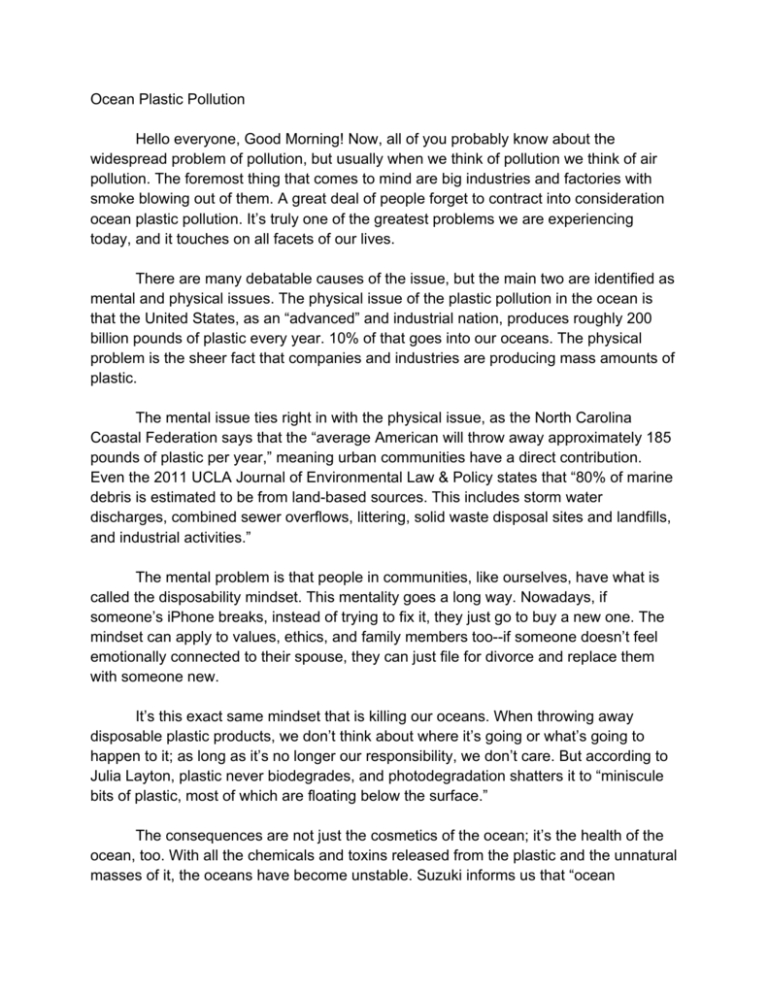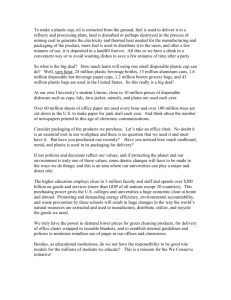Ocean Plastic Pollution: Causes, Effects & Solutions
advertisement

Ocean Plastic Pollution Hello everyone, Good Morning! Now, all of you probably know about the widespread problem of pollution, but usually when we think of pollution we think of air pollution. The foremost thing that comes to mind are big industries and factories with smoke blowing out of them. A great deal of people forget to contract into consideration ocean plastic pollution. It’s truly one of the greatest problems we are experiencing today, and it touches on all facets of our lives. There are many debatable causes of the issue, but the main two are identified as mental and physical issues. The physical issue of the plastic pollution in the ocean is that the United States, as an “advanced” and industrial nation, produces roughly 200 billion pounds of plastic every year. 10% of that goes into our oceans. The physical problem is the sheer fact that companies and industries are producing mass amounts of plastic. The mental issue ties right in with the physical issue, as the North Carolina Coastal Federation says that the “average American will throw away approximately 185 pounds of plastic per year,” meaning urban communities have a direct contribution. Even the 2011 UCLA Journal of Environmental Law & Policy states that “80% of marine debris is estimated to be from land-based sources. This includes storm water discharges, combined sewer overflows, littering, solid waste disposal sites and landfills, and industrial activities.” The mental problem is that people in communities, like ourselves, have what is called the disposability mindset. This mentality goes a long way. Nowadays, if someone’s iPhone breaks, instead of trying to fix it, they just go to buy a new one. The mindset can apply to values, ethics, and family members too--if someone doesn’t feel emotionally connected to their spouse, they can just file for divorce and replace them with someone new. It’s this exact same mindset that is killing our oceans. When throwing away disposable plastic products, we don’t think about where it’s going or what’s going to happen to it; as long as it’s no longer our responsibility, we don’t care. But according to Julia Layton, plastic never biodegrades, and photodegradation shatters it to “miniscule bits of plastic, most of which are floating below the surface.” The consequences are not just the cosmetics of the ocean; it’s the health of the ocean, too. With all the chemicals and toxins released from the plastic and the unnatural masses of it, the oceans have become unstable. Suzuki informs us that “ocean currents, upwellings, oxygen levels, acidity, and temperature are changing in ways we haven't seen before... We rely on our oceans for transportation, recreation, and numerous resources. And oceans provide almost half the oxygen we breathe.” We rely on all of these matters, especially oxygen for a mere survival. Without the oxygen that the ocean provides, air pollution would be even worse. If that’s not enough, our own ecosystem and the biodiversity we need to survive is also at risk. Sesini confirms that “267 species worldwide and over a million sea-birds and one hundred thousand marine mammals and sea turtles are killed each year by ingestion of plastics or entanglement.” For the animals that do manage to survive, they can get transported into non native-waters because the plastic can act as a floating raft. We rely on fish, not only as food, but as a part of biodiversity. Godoy emphasizes the importance of this, as “the loss of biodiversity is a self-multiplying process. The disappearance of one species disturbs the fragile equilibrium of nature by breaking the chain food within biological habitats, thus putting other species' existence at risk, forcing them to emigrate, adapt, or to die. What then can we do about it? We certainly can’t sweep nets across the ocean, because photodegradation has made plastic so small that doing that would kill an equal amount of sea life. We call for a new and innovative solution that can solve the harm we’ve already done, and also stop it from proceeding. I propose that the U.S. deploys a system of passive ocean clean up arrays to garbage patches. These arrays take advantage of the natural sea currents and winds by using passive collection to effectively and efficiently capture the plastic. It’s estimated that we will be able to clean up half of the plastic debris in the Great Pacific Garbage Patch, the biggest accumulation of trash in the ocean, within just 10 years. Instead of using nets and vessels that marine life may get entangled in, solid floating barriers would be deployed to catch, collect, and concentrate the debris. The arrays do a good job of handling what’s already happened, and they will likewise contribute to solving the disposability mindset because it will make people more aware of the seriousness of their actions. Still, it won’t be able to completely solve the mindset itself. That’s why we should simultaneously initiate a plan designed to change our mentality. We’ve been taught the R’s: Reduce, Reuse, Recycle which is a terrific way to start, but now it’s time to add “Refuse” to that list. So many items are packaged in plastic, which is packaged in a box, which is then also packaged in plastic. Consider all the drinks you buy that are each individually packaged in plastic. Think about every plastic bag, plastic cup, plastic to-go container that is designed for a one-time use. If we truly minimize plastic consumption, this strategy is certain to be successful. I’ll end with this: I believe that the most important thing to keep in mind is that the disposability mentality is the cause of all these issues, including the moral and ethical ones, too. So the next time you break up, and you’re told that there are plenty of fish in the sea—remember, there’s actually more plastic. Works Cited Maloney, Skip. “The 'Plastic Ocean' and Bonnie Monteleone.” North Carolina Coastal Federation. 13 Feb. 2013. Web. 22 Nov. 2014. Harse, Grant A. “Plastic, the Great Pacific Garbage Patch, and International Misfires at a Cure.” UCLA Journal of Environmental Law and Policy. 2011. Web. 20 Nov. 2014. Layton, Julia. “Could we clean up the Great Pacific Garbage Patch?” Discovery Communications. 2010. Web. 23 Nov. 2014. Leverett, Merium. “Going Green with values and ethics in the 21st Century.” Journal of Practical Consulting. 2014. Web. 24 Nov. 2014. Sesini, Marzia. “The Garbage Patch in the Oceans: The Problem and the Possible Solutions.” Columbia University. 2011. Web. 24 Nov. 2014. Suzuki, David. Moola, Faisal. “All life depends on the oceans.” David Suzuki Foundation. 13 Nov. 2009. Web. 24 Nov. 2014. “Marine Debris Impacts." US Environmental Protection Agency. 6 Mar. 2012. Web. 24 Nov. 2014. Godoy, Julio. “Not Enough Done to Protect Biodiversity.” Common Dreams. 21 May 2008. Web. 25 Nov. 2014. Slat, Boyan. “Responding to Critics.” The Ocean Cleanup. 8 June 2014. Web. 24 Nov. 2014. Dawkes, Gary. “Sustainable Solution Could Clean Up Our Oceans.” Ocean Hub. 5 June 2014. Web. 25 Nov. 2014.







